belt Lancia Delta 2015 Owner handbook (in English)
[x] Cancel search | Manufacturer: LANCIA, Model Year: 2015, Model line: Delta, Model: Lancia Delta 2015Pages: 291, PDF Size: 6.74 MB
Page 161 of 291

SAFETY159
2
GENERAL INSTRUCTIONS FOR USING
THE SEAT BELTS
The driver is responsible for complying with, and ensur-
ing that all the other occupants of the car also comply with,
the local laws in force in relation to the use of the seat belts.
Always fasten the seat belts before setting off.
Seat belts are also to be worn by pregnant women: the risk
of injury in the case of impact is greatly reduced for them
and the unborn child if they are wearing a seat belt.
Pregnant women must position the lower part of the belt
very low down so that it passes over the pelvis and under
the abdomen (see fig. 3). The best way to protect the un-
born child is to protect the mother. When a safety belt is
worn properly, it is more likely that the unborn child will
not be hurt in a crash. For pregnant women, as for any-
one, the key to making safety belts effective is wearing
them properly.
For maximum protection, keep the backrest
upright, lean back into it and make sure the
seat belt fits closely across your chest and
pelvis. Always fasten the seat belts on both the front
and the rear seats! Travelling without wearing seat
belts will increase the risk of serious injury and even
death in the event of an accident.
fig. 3L0E0404m
The belt must not be twisted. The upper part must pass
over the shoulder and cross the chest diagonally. The low-
er part must fit over the pelvis (as shown in fig. 4) rather
than the abdomen of the passenger.
Never use devices (clips, clamps, etc.) to hold the seat belt
away from your body.
Removing or otherwise tampering with seat
belt and pretensioner components is strictly
prohibited. Any operations on these compo-
nents must be performed by qualified and autho-
rised technicians. Always go to a Lancia Dealer-
ship.
155-182 Delta GB 1ed 26/08/13 11.29 Pagina 159
Page 162 of 291

160SAFETY
If the belt has been subjected to a high level
of stress, for example after an accident, it
must be completely replaced together with the
attachments, attachment fixing screws and the pre-
tensioner. In fact, even if the belt has no visible de-
fects, it could have lost its resilience.
SEAT BELT MAINTENANCE
For keeping the seat belts in efficient conditions, observe
the following:
❍ always make sure the belt is well stretched and never
twisted; make sure that it is free to run without ob-
structions;
❍ check seat belt operation as follows: attach the seat belt
and pull it hard;
❍ replace the belt after an accident of a certain severity
even if it does not appear to be damaged. Always re-
place the seat belt if the pretensioners were deployed;
❍ to clean seat belts, wash by hand with water and mild
soap, rinse and leave to dry in the shade. Never use
strong detergents, bleach, paints or any other substance
which could damage the belt fibres;
Each seat belt must be used by only one person. Never
travel with a child sitting on the passenger’s lap using the
seat belts to protect them both, fig. 5.
Do not fasten any other object to the body.
fig. 4L0E0403mfig. 5L0E0405m
155-182 Delta GB 1ed 26/08/13 11.29 Pagina 160
Page 163 of 291
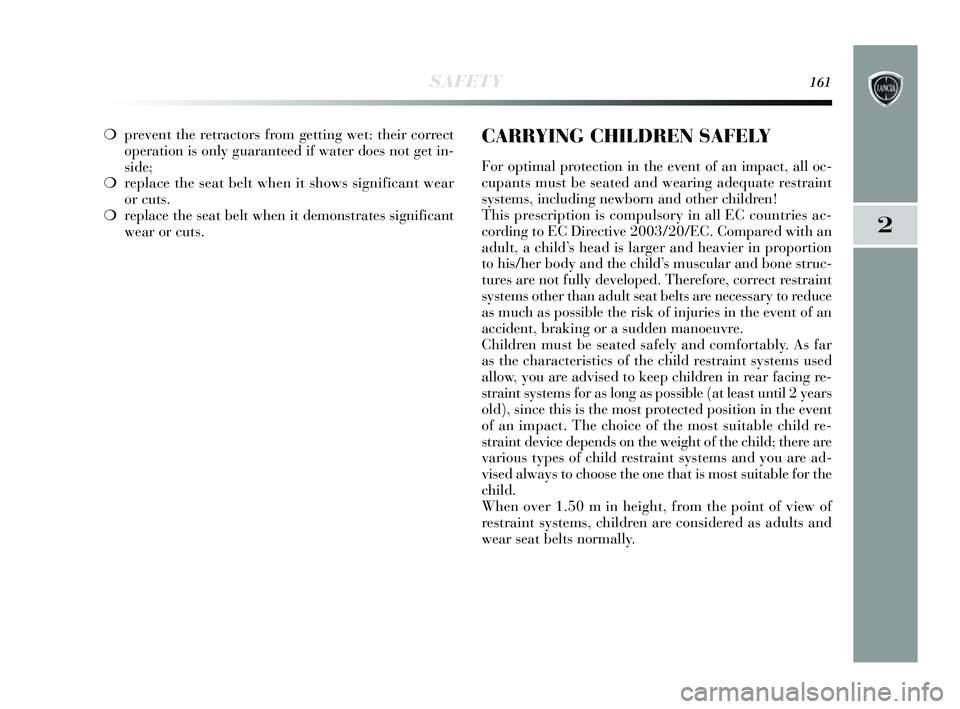
SAFETY161
2
❍prevent the retractors from getting wet: their correct
operation is only guaranteed if water does not get in-
side;
❍ replace the seat belt when it shows significant wear
or cuts.
❍ replace the seat belt when it demonstrates significant
wear or cuts.CARRYING CHILDREN SAFELY
For optimal protection in the event of an impact, all oc-
cupants must be seated and wearing adequate restraint
systems, including newborn and other children!
This prescription is compulsory in all EC countries ac-
cording to EC Directive 2003/20/EC. Compared with an
adult, a child’s head is larger and heavier in proportion
to his/her body and the child’s muscular and bone struc-
tures are not fully developed. Therefore, correct restraint
systems other than adult seat belts are necessary to reduce
as much as possible the risk of injuries in the event of an
accident, braking or a sudden manoeuvre.
Children must be seated safely and comfortably. As far
as the characteristics of the child restraint systems used
allow, you are advised to keep children in rear facing re-
straint systems for as long as possible (at least until 2 years
old), since this is the most protected position in the event
of an impact. The choice of the most suitable child re-
straint device depends on the weight of the child; there are
various types of child restraint systems and you are ad-
vised always to choose the one that is most suitable for the
child.
When over 1.50 m in height, from the point of view of
restraint systems, children are considered as adults and
wear seat belts normally.
155-182 Delta GB 1ed 26/08/13 11.29 Pagina 161
Page 165 of 291
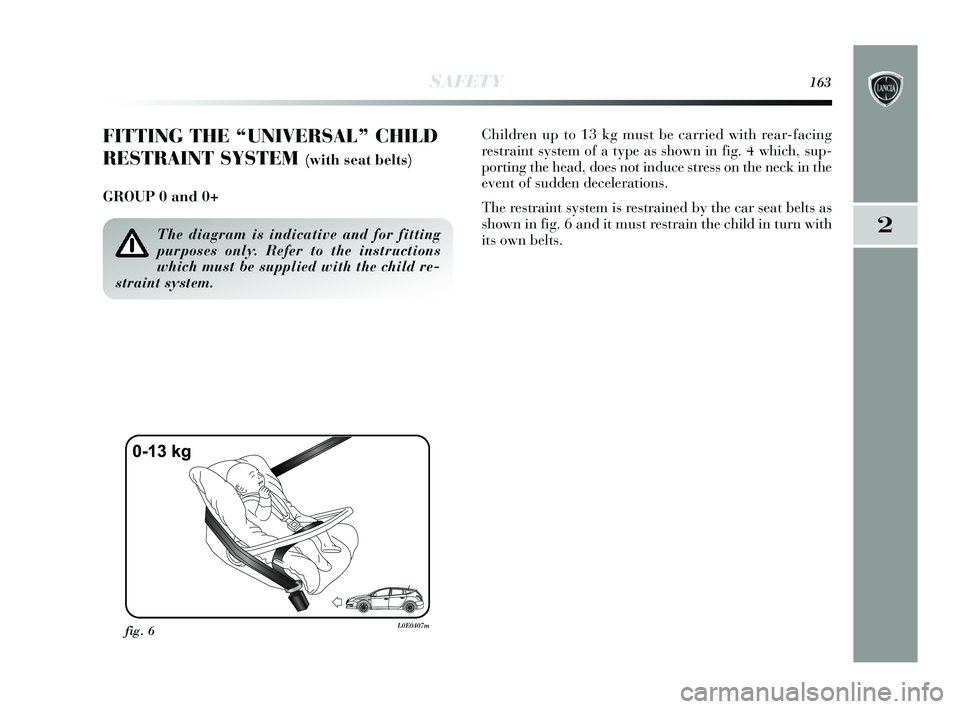
SAFETY163
2
FITTING THE “UNIVERSAL” CHILD
RESTRAINT SYSTEM
(with seat belts)
GROUP 0 and 0+ Children up to 13 kg must be carried with rear-facing
restraint system of a type as shown in fig. 4 which, sup-
porting the head, does not induce stress on the neck in the
event of sudden decelerations.
The restraint system is restrained by the car seat belts as
shown in fig. 6 and it must restrain the child in turn with
its own belts.
The diagram is indicative and for fitting
purposes only. Refer to the instructions
which must be supplied with the child re-
straint system.
fig. 6L0E0407m
155-182 Delta GB 1ed 26/08/13 11.29 Pagina 163
Page 166 of 291
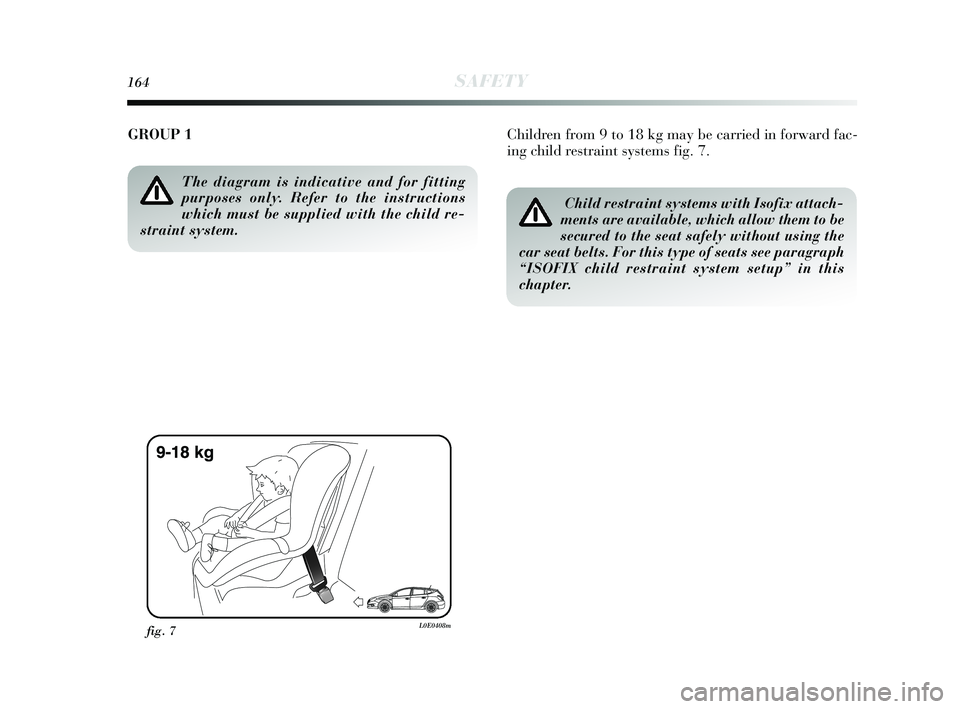
164SAFETY
Children from 9 to 18 kg may be carried in forward fac-
ing child restraint systems fig. 7.
GROUP 1
The diagram is indicative and for fitting
purposes only. Refer to the instructions
which must be supplied with the child re-
straint system.
Child restraint systems with Isofix attach-
ments are available, which allow them to be
secured to the seat safely without using the
car seat belts. For this type of seats see paragraph
“ISOFIX child restraint system setup” in this
chapter.
fig. 7L0E0408m
155-182 Delta GB 1ed 26/08/13 11.29 Pagina 164
Page 167 of 291
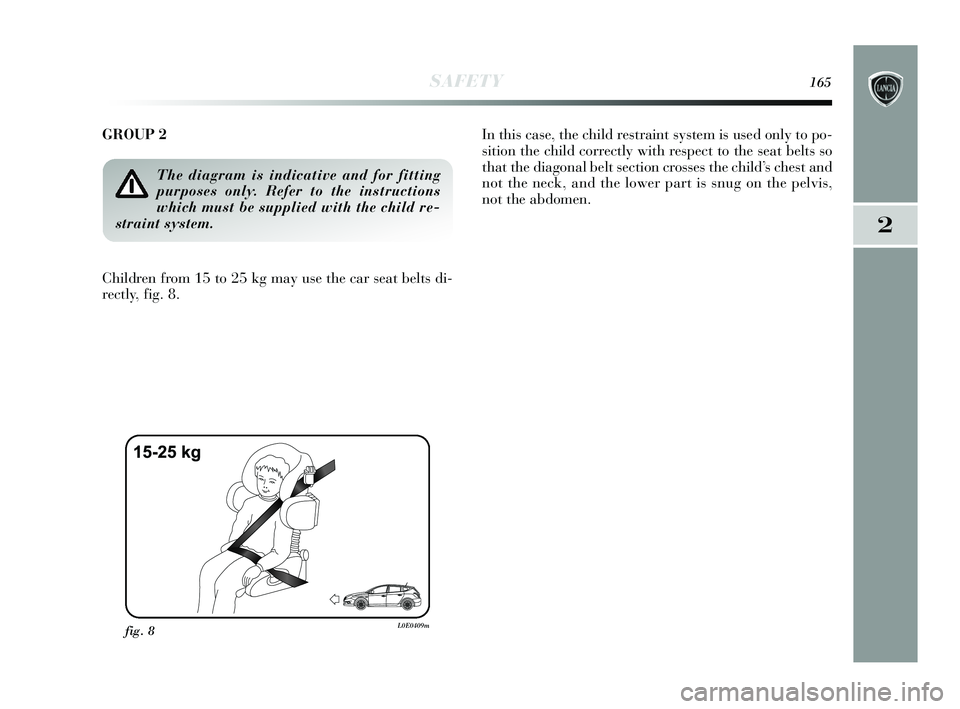
SAFETY165
2
GROUP 2
Children from 15 to 25 kg may use the car seat belts di-
rectly, fig. 8.In this case, the child restraint system is used only to po-
sition the child correctly with respect to the seat belts so
that the diagonal belt section crosses the child’s chest and
not the neck, and the lower part is snug on the pelvis,
not the abdomen.
The diagram is indicative and for fitting
purposes only. Refer to the instructions
which must be supplied with the child re-
straint system.
fig. 8L0E0409m
155-182 Delta GB 1ed 26/08/13 11.29 Pagina 165
Page 168 of 291
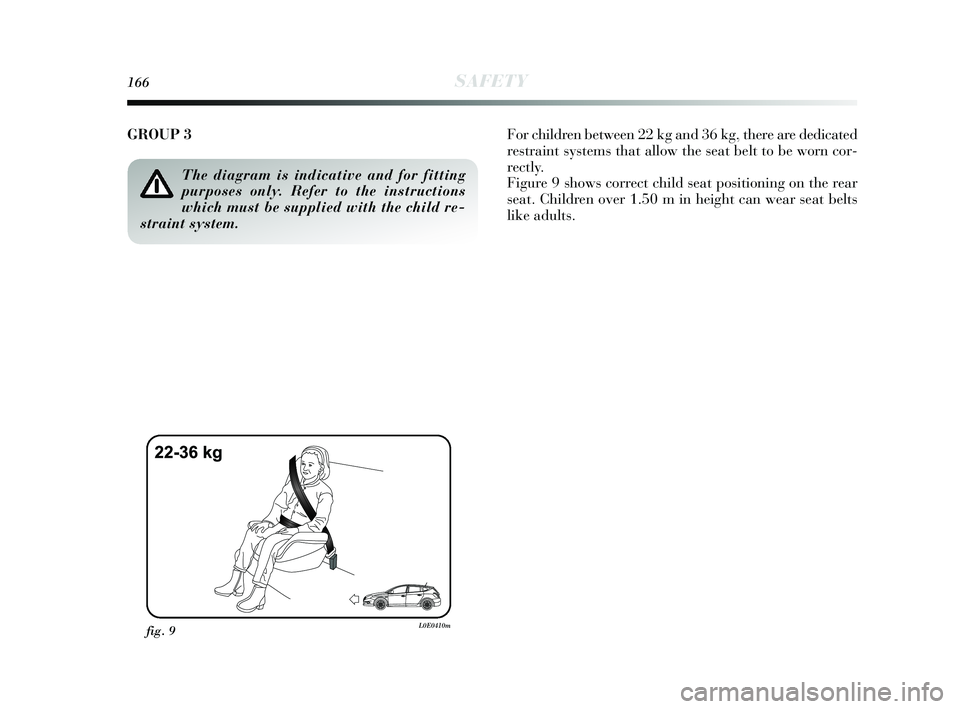
166SAFETY
GROUP 3 For children between 22 kg and 36 kg, there are dedicated
restraint systems that allow the seat belt to be worn cor-
rectly.
Figure 9 shows correct child seat positioning on the rear
seat. Children over 1.50 m in height can wear seat belts
like adults.
The diagram is indicative and for fitting
purposes only. Refer to the instructions
which must be supplied with the child re-
straint system.
fig. 9L0E0410m
155-182 Delta GB 1ed 26/08/13 11.29 Pagina 166
Page 172 of 291

170SAFETY
fig. 11L0E0233m
Fit the child restraint system when the car
is stationary. The child restraint system is
correctly fixed to the brackets when you hear
the click. Follow the instructions for assembly, dis-
assembly and positioning that the manufacturer
must supply with the child restraint system.
INSTALLING A UNIVERSAL ISOFIX CHILD
RESTRAINT SYSTEM
Due to its different anchoring system, the child restraint
system must be anchored to the dedicated lower metal
rings A - fig. 11, set between rear seat backrest and rear
cushion. After removing the parcel shelf, secure the upper belt (provided with the child restraint system) to the spe-
cific ring (after having opened the covering zip B - fig. 11)
located in the rear seat backrest.
Remember that when using a Universal Isofix child re-
straint system, you can use all type-approved systems with
the marking ECE R44 (R44/03 or superior) “Universal
Isofix”.
The Universal Isofix “Duo Plus” child restraint system and
the special “G 0/1” system are available from Lineacces-
sori Lancia.
For any further details on installation/use, refer to the
instruction manual for the child restraint system.
155-182 Delta GB 1ed 26/08/13 11.29 Pagina 170
Page 174 of 291

172SAFETY
Main instructions for carrying children safely:
❍Install the child restraint systems on the rear seat,
which is the most protected position in the event of
an accident.
❍ Keep children in rear facing restraint systems for as
long as possible, until 3–4 years old if possible.
❍ Should a rear facing child restraint system be installed
on the rear seats, it is advisable to position it as far for-
ward as the position of the front seat allows.
❍ If the front passenger’s airbag is deactivated always
check that the dedicated warning light is permanent-
ly switched on on the instrument panel to make sure
that it has actually been deactivated.
❍ Carefully follow the instructions supplied with the child
restraint system itself. Keep the instructions in the car
along with the other documents and this handbook.
Do not use second-hand child restraint systems with-
out instructions. ❍
Only one child is to be strapped to each retaining sys-
tem; never use it to transport two children at once.
❍ Always check that the seat belts do not interfere with
the child’s throat.
❍ Always check that the seat belt is well fastened by
pulling on it.
❍ While travelling, do not let the child sit incorrectly or
unfasten the belts.
❍ Never allow a child to put the belt’s diagonal section
under an arm or behind their back.
❍ Never carry children on your lap, even newborns. No-
one can restrain a child in the event of an accident.
❍ In the event of an accident, replace the child restraint
system with a new one.
Fit the child restraint system according to the
instructions, which must be included.
155-182 Delta GB 1ed 26/08/13 11.29 Pagina 172
Page 175 of 291
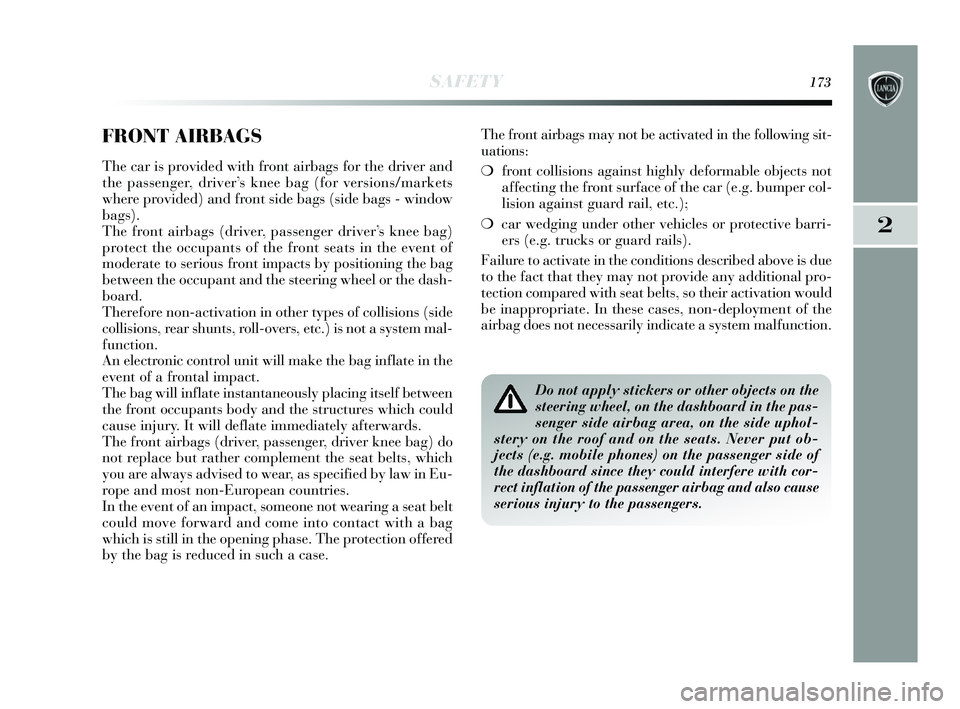
SAFETY173
2
FRONT AIRBAGS
The car is provided with front airbags for the driver and
the passenger, driver’s knee bag (for versions/markets
where provided) and front side bags (side bags - window
bags).
The front airbags (driver, passenger driver’s knee bag)
protect the occupants of the front seats in the event of
moderate to serious front impacts by positioning the bag
between the occupant and the steering wheel or the dash-
board.
Therefore non-activation in other types of collisions (side
collisions, rear shunts, roll-overs, etc.) is not a system mal-
function.
An electronic control unit will make the bag inflate in the
event of a frontal impact.
The bag will inflate instantaneously placing itself between
the front occupants body and the structures which could
cause injury. It will deflate immediately afterwards.
The front airbags (driver, passenger, driver knee bag) do
not replace but rather complement the seat belts, which
you are always advised to wear, as specified by law in Eu-
rope and most non-European countries.
In the event of an impact, someone not wearing a seat belt
could move forward and come into contact with a bag
which is still in the opening phase. The protection offered
by the bag is reduced in such a case.The front airbags may not be activated in the following sit-
uations:
❍
front collisions against highly deformable objects not
affecting the front surface of the car (e.g. bumper col-
lision against guard rail, etc.);
❍ car wedging under other vehicles or protective barri-
ers (e.g. trucks or guard rails).
Failure to activate in the conditions described above is due
to the fact that they may not provide any additional pro-
tection compared with seat belts, so their activation would
be inappropriate. In these cases, non-deployment of the
airbag does not necessarily indicate a system malfunction.
Do not apply stickers or other objects on the
steering wheel, on the dashboard in the pas-
senger side airbag area, on the side uphol-
stery on the roof and on the seats. Never put ob-
jects (e.g. mobile phones) on the passenger side of
the dashboard since they could interfere with cor-
rect inflation of the passenger airbag and also cause
serious injury to the passengers.
155-182 Delta GB 1ed 26/08/13 11.29 Pagina 173